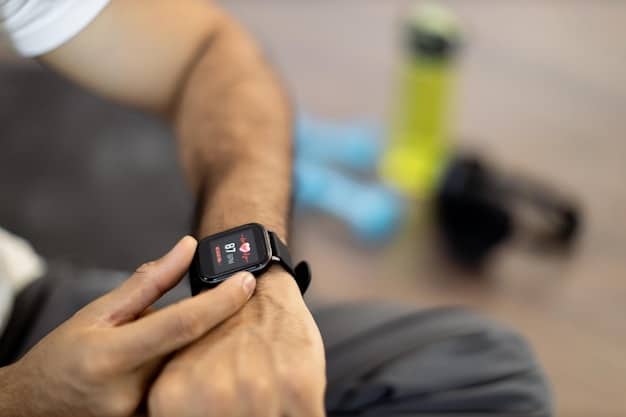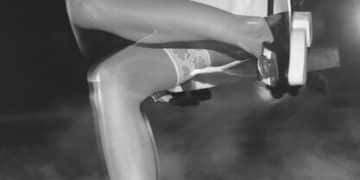Power Up Your Heart: Cardio for Cardiovascular Health in 2025

Cardiovascular exercise, commonly known as cardio, is crucial for improving heart health by strengthening the heart muscle, enhancing circulation, and managing key risk factors for disease in 2025.
As we step into 2025, the focus on holistic well-being intensifies, and at its core lies cardiovascular health. Understanding how to use cardio to improve your cardiovascular health in 2025 is not just about extending lifespan, but about enhancing the quality of every single day through increased vitality and resilience.
The Foundational Role of Cardiovascular Health
Cardiovascular health is the bedrock of overall well-being, influencing everything from energy levels to cognitive function. In 2025, with advancements in fitness science and a growing awareness of preventive health, the mechanisms through which cardio benefits the heart are clearer than ever. It’s about more than just burning calories; it’s about robust physiological adaptations that safeguard our most vital organ.
The heart, a muscular pump, thrives on regular challenges. Engage it rigorously, and it responds by becoming more efficient and resilient. This efficiency translates to a lower resting heart rate, a stronger pump with each beat, and improved blood flow throughout the body. These are not merely abstract benefits; they are tangible improvements that translate into better performance in daily tasks and a reduced risk of serious health conditions.
Understanding the Heart’s Response to Cardio
When you engage in cardiovascular exercise, your heart rate increases, and your breathing deepens. This immediate physiological response sets off a cascade of long-term adaptations within your cardiovascular system. These changes are cumulative, building a stronger and healthier heart over time. It’s a testament to the body’s incredible adaptability and its capacity for positive change when stimulated appropriately.
- Strengthened Heart Muscle: Regular cardio makes the heart muscle stronger and more efficient at pumping blood with less effort.
- Improved Circulation: Exercise enhances the network of blood vessels, increasing oxygen and nutrient delivery to cells and tissues.
- Lower Blood Pressure: Cardio helps make blood vessels more elastic, reducing resistance to blood flow and lowering pressure.
- Better Cholesterol Profile: It can increase beneficial HDL cholesterol while reducing harmful LDL cholesterol and triglycerides.
Beyond these direct effects, cardio also indirectly supports cardiovascular health by helping with weight management, reducing stress, and improving sleep quality. These supportive benefits create a holistic environment where the heart can truly flourish. The interconnectedness of these factors means that a commitment to cardiovascular exercise pays dividends across multiple aspects of health.
Establishing Your Cardio Baseline and Goals for 2025
Before diving into any exercise regimen, especially one aimed at cardiovascular improvement, understanding your current fitness level is paramount. This assessment not only provides a starting point but also helps in setting realistic and progressive goals. For 2025, personalized approaches are gaining prominence, acknowledging that one size does not fit all in fitness programming.
Starting too intensely can lead to injury or burnout, while an insufficient stimulus will yield minimal results. A gradual, methodical approach, tailored to individual capabilities and preferences, is key to sustainable progress. This personalized journey ensures that you remain motivated and continually challenge your body in a safe and effective manner.
Consulting with healthcare professionals or certified fitness trainers can offer valuable insights and guidance, ensuring your plans align with your health status and ambitions. They can help you identify any potential limitations and design a program that is both effective and safe for your specific needs, setting you up for success in your cardiovascular health journey.
Assessing Your Current Fitness Level
Several simple tests can help you gauge your cardiovascular fitness. These benchmarks are not about perfection, but about establishing a baseline from which to measure your progress. Knowing these metrics can provide tangible evidence of your improvements, serving as powerful motivators.
- Resting Heart Rate: A lower resting heart rate often indicates better cardiovascular efficiency.
- Walk Test: Measures the distance you can cover in a set time (e.g., 12 minutes) to assess aerobic capacity.
- Talk Test: Determines exercise intensity by checking if you can carry on a conversation while exercising.
Once you have a clear picture of your baseline, setting SMART (Specific, Measurable, Achievable, Relevant, Time-bound) goals becomes a straightforward process. These goals should guide your cardio training, keeping you focused and accountable. Remember, progress is rarely linear, and adapting your goals as you improve is a natural part of the process.
Effective Cardio Modalities for Heart Health in 2025
The landscape of cardiovascular exercise is rich and varied, offering options to suit every preference, fitness level, and schedule. In 2025, the emphasis remains on finding activities that you genuinely enjoy, as consistency is the ultimate determinant of success. The best cardio for you is the one you will do regularly.
From traditional running and cycling to more contemporary approaches like high-intensity interval training (HIIT), each modality offers unique benefits. Understanding these differences allows for purposeful selection and integration into a well-rounded fitness routine. The key is to blend effectiveness with enjoyment to ensure long-term adherence.
Variety is not just the spice of life; it’s also a powerful tool in fitness. Rotating between different cardio types prevents boredom, challenges your body in new ways, and reduces the risk of overuse injuries. This dynamic approach keeps your workouts fresh and engaging, sustaining your motivation throughout the year.
Popular and Emerging Cardio Options
The diversity of cardio exercises means there’s always something new to try or an old favorite to rediscover. For 2025, smart wearables and app-based coaching are making it easier to track progress and stay motivated, further enhancing the accessibility of various modalities.
- Running/Jogging: A classic, accessible option that can be done outdoors or on a treadmill.
- Cycling: Low-impact and great for joint health, available as outdoor rides or stationary biking.
- Swimming: A full-body workout that’s gentle on joints and excellent for overall cardiovascular conditioning.
- High-Intensity Interval Training (HIIT): Short bursts of intense exercise followed by brief recovery periods, highly efficient for improving aerobic capacity.
- Dancing: A fun and engaging way to elevate your heart rate and improve coordination.

Emerging trends also point towards the integration of virtual reality (VR) fitness and interactive gaming, making cardio workouts more immersive and entertaining. These innovations broaden the appeal of exercise, drawing in individuals who might otherwise find traditional methods less appealing. The future of cardio is increasingly personalized and engaging.
Structuring Your Cardio Workouts: Frequency, Intensity, Time, Type (FITT)
The FITT principle—Frequency, Intensity, Time, Type—provides a fundamental framework for designing an effective exercise program. Applying this principle systematically ensures that your cardio workouts are optimized for cardiovascular health improvement, rather than being random or haphazard. For 2025, precision in planning is key.
Understanding how each component interacts allows for intelligent adjustments as your fitness progresses or as life demands change. It’s about finding the sweet spot where effort meets results, ensuring you’re challenging your body enough without overtraining. This balanced approach is crucial for sustained progress and injury prevention.
Regular reassessment of your FITT parameters is essential. What was challenging six months ago might now be too easy, signaling a need to increase intensity or duration. This iterative process prevents plateaus and keeps your body adapting and improving, pushing your cardiovascular limits in a healthy way.
Applying the FITT Principle in 2025
The guidelines for cardiovascular health generally recommend consistency and appropriate challenge. However, individual circumstances dictate the specific application of these principles, making tailoring essential.
- Frequency: Aim for at least 3-5 days of moderate-to-vigorous cardio per week. Consistency is more important than sporadic intense efforts.
- Intensity: Focus on maintaining your heart rate within your target zone. This can be monitored using heart rate monitors or perceived exertion scales (e.g., the “talk test”).
- Time: Accumulate at least 150 minutes of moderate-intensity cardio or 75 minutes of vigorous-intensity cardio per week. Longer durations generally yield greater benefits.
- Type: Incorporate a variety of cardio activities to engage different muscle groups and keep workouts fresh and challenging.
Integrating these elements requires careful planning. For example, a beginner might start with three 30-minute moderate walks per week and gradually increase duration, frequency, or intensity over time. An advanced individual might incorporate HIIT sessions twice a week along with longer endurance workouts on other days. The key is progressive overload, continually challenging your cardiovascular system to adapt and strengthen.
Remember, listening to your body is paramount. Some days you might need to scale back, while others you’ll feel ready to push harder. Flexibility within your FITT plan ensures adherence and long-term success. It’s a dynamic relationship between effort and recovery, leading to sustainable cardiovascular gains.
Nutrition and Recovery: Pillars of Cardiovascular Health
While cardio exercise directly strengthens the heart, its effectiveness is amplified exponentially when supported by optimal nutrition and adequate recovery. These two factors are not merely supplemental; they are integral to a holistic approach to cardiovascular health. In 2025, the synergy between exercise, diet, and rest is better understood and emphasized than ever.
Proper fueling provides the energy needed for workouts and the nutrients essential for cellular repair and regeneration. Without it, even the most dedicated exercise routine can fall short of its potential. Similarly, allowing the body to recover prevents overtraining, reduces injury risk, and ensures adaptations from exercise can fully manifest.
The choices we make regarding what we eat and how we recover directly influence inflammation, blood pressure, cholesterol levels, and overall functionality of the cardiovascular system. It’s a continuous cycle of stress and adaptation, powered by intelligent choices in diet and rest. Ignoring these pillars is akin to building a house on sand.
Fueling Your Heart and Body
A diet rich in whole foods supports cardiovascular health and optimizes performance. Think of food as fuel, providing the clean energy your body—and especially your heart—needs to perform at its best.
- Whole Grains: Provide sustained energy and fiber, which helps manage cholesterol.
- Lean Proteins: Essential for muscle repair and growth, supporting overall body function.
- Healthy Fats: Omega-3 fatty acids, found in fish and nuts, are crucial for heart health and reducing inflammation.
- Fruits and Vegetables: Packed with vitamins, minerals, and antioxidants that protect against cellular damage.
Hydration is equally critical. Water supports blood circulation, nutrient transport, and temperature regulation, all vital for
cardiovascular function during and after exercise. Dehydration can
significantly impair performance and strain the heart.
Prioritizing Recovery
Recovery is where the magic happens. Exercise creates microscopic tears in muscle fibers and stresses the cardiovascular system. During recovery, the body repairs and rebuilds, leading to stronger, more resilient tissues and a more efficient heart.
- Adequate Sleep: Crucial for hormonal balance, tissue repair, and reducing inflammation. Aim for 7-9 hours per night.
- Active Recovery: Light activities like walking or gentle stretching can improve blood flow and aid muscle recovery.
- Rest Days: Incorporating planned rest days prevents burnout and allows the body to fully adapt to training stressors.
Ignoring recovery can lead to diminishing returns, increased injury risk, and chronic fatigue. It’s a vital component of any effective fitness plan, ensuring that your efforts in cardio translate into long-term cardiovascular health improvements. The body’s capacity for repair is immense, but it requires the right conditions to thrive.
Monitoring Progress and Adapting Your Cardio Plan
The journey to improved cardiovascular health is dynamic, not a static destination. Regularly monitoring your progress allows you to celebrate achievements, identify areas for improvement, and adapt your cardio plan effectively. For 2025, the accessibility of data through wearables and health apps makes this process more insightful than ever.
Without tracking, it’s easy to lose sight of how far you’ve come or to continue with a routine that is no longer challenging enough. Consistent monitoring provides valuable feedback, guiding the necessary adjustments to frequency, intensity, duration, or type of exercise. This iterative process ensures continuous improvement and prevents plateaus.
Beyond numbers, it’s important to pay attention to how you feel. Increased energy, improved mood, and better sleep are all indicators of positive cardiovascular adaptation. These qualitative measures are just as important as quantitative data in assessing overall progress and well-being.
Tools and Metrics for Tracking
A range of tools can assist in monitoring your cardiovascular health progress, from simple self-assessments to sophisticated wearable technology. These tools provide objective data points to inform your decisions.
- Heart Rate Monitors: Provide real-time feedback on exercise intensity and help you stay within target zones.
- Fitness Trackers/Smartwatches: Monitor daily activity, steps, calories burned, sleep patterns, and often heart rate, offering a holistic view of your health.
- Fitness Journals: Manually log workouts, perceived effort, and how you felt, offering qualitative insights.
- Regular Health Check-ups: Periodically assess key health markers like blood pressure, cholesterol, and body composition.

Interpreting this data involves looking for trends rather than focusing on single data points. A gradual decrease in resting heart rate, an increase in exercise duration at the same intensity, or improved recovery times are all positive signs. Conversely, a plateau or decline might signal a need to modify your routine.
Adjusting your plan might involve increasing workout duration, incorporating more challenging intervals, diversifying your cardio activities, or even reassessing your nutrition and recovery strategies. The goal is to continuously provide a sufficient stimulus for your cardiovascular system to adapt and grow stronger. This proactive approach ensures you remain on the path to optimal heart health.
Addressing Common Challenges and Staying Motivated
Even with the best intentions and a well-structured plan, challenges are an inevitable part of any fitness journey. Lack of time, motivation dips, plateaus, and minor setbacks can all derail progress. In 2025, acknowledging these hurdles proactively and developing strategies to overcome them is crucial for long-term consistency in cardiovascular training.
Motivation is not a constant; it ebbs and flows. Understanding this allows for a more compassionate yet firm approach to your routine. It’s about building habits and resilience, so that even on days when motivation is low, the routine can carry you through. This consistency is what ultimately yields significant health benefits.
Problem-solving and adaptability become invaluable skills. Instead of viewing challenges as failures, see them as opportunities to learn more about your body, your preferences, and what truly works for you. Every obstacle overcome strengthens your commitment and self-efficacy.
Strategies for Overcoming Obstacles
Effective strategies often involve a combination of practical adjustments and psychological resilience. Developing a toolkit of solutions can help you navigate the ups and downs of your fitness path.
- Time Management: Schedule workouts like important appointments, breaking them into smaller, manageable chunks if necessary (e.g., three 10-minute walks instead of one 30-minute session).
- Vary Your Routine: Combat boredom by trying new activities, exploring different routes, or joining a fitness class. Novelty can reignite enthusiasm.
- Set Realistic Expectations: Understand that progress isn’t linear. Celebrate small victories and don’t be discouraged by occasional setbacks.
- Find a Workout Buddy: Accountability partners can provide encouragement and make exercise more enjoyable.
- Reward System: Acknowledge your efforts with non-food rewards that reinforce positive behavior.
Addressing plateaus often requires a change in stimulus. This could mean increasing the intensity, duration, or type of exercise, or incorporating cross-training elements to challenge your body in new ways. Sometimes, a brief period of rest can also help the body reset and overcome a slump.
Ultimately, staying motivated is about connecting with your ‘why.’ Remind yourself of the profound benefits of improved cardiovascular health – more energy, better mood, reduced disease risk, and a higher quality of life. This deeper understanding fuels intrinsic motivation, turning a task into a true passion for well-being.
The Future of Cardiovascular Health and Cardio in 2025
As we navigate 2025 and beyond, the intersection of technology, personalized medicine, and a deeper understanding of human physiology will continue to shape how we approach cardiovascular health. The evolution of cardio is not just about new exercises, but about innovative ways to integrate physical activity seamlessly into daily life, making it more accessible, effective, and engaging for everyone.
Predictive analytics, fueled by data from wearable devices and AI, will likely offer hyper-personalized exercise recommendations, capable of adapting in real-time to an individual’s health metrics, sleep patterns, and even stress levels. This precision medicine approach to fitness could revolutionize preventive care, moving from general guidelines to highly specific prescriptions tailored to individual needs.
The concept of “exercise as medicine” will continue to gain traction, with healthcare providers increasingly prescribing specific cardio regimens as part of treatment plans for various conditions, not just as a general recommendation. This integration underscores the profound therapeutic power of physical activity.
Innovations and Trends on the Horizon
Several emerging trends highlight the exciting direction of cardiovascular health and cardio. These innovations aim to make fitness more integrated, data-driven, and enjoyable for a broader population.
- Hyper-Personalized Training: AI-driven platforms will provide real-time coaching and adjust workouts based on biometric data.
- Genomic-Based Fitness: Tailoring exercise types and intensities based on an individual’s genetic predispositions for better efficacy and injury prevention.
- Gamified Fitness and VR Workouts: Making exercise more engaging and fun through immersive digital experiences that blur the lines between play and physical activity.
- Community-Driven Health Platforms: Increased emphasis on social connection and peer support to sustain motivation and collective health goals.
- Digital Therapeutics: Prescription-grade digital programs that use exercise interventions to manage or prevent chronic cardiovascular diseases.
Furthermore, expect to see an increased focus on the synergistic effects of different health components, such as combining cardio with mindfulness practices to reduce stress, or integrating it with strength training for holistic physical resilience. The future leans towards integrated wellness, where cardiovascular health is seen not in isolation, but as a core component of overall thriving.
The role of environmental factors will also become more prominent, with urban planning evolving to encourage active transportation and access to green spaces, thus fostering a built environment that supports continuous physical activity. As 2025 unfolds, embracing these advancements will empower individuals to take more informed and proactive steps in cultivating robust heart health for years to come.
| Key Takeaway | Brief Description |
|---|---|
| ❤️ Heart Strengthening | Cardio directly strengthens the heart muscle, making it more efficient at pumping blood. |
| 🎯 FITT Principle | Optimize workouts using Frequency, Intensity, Time, Type for consistent results. |
| 🍏 Holistic Approach | Combine cardio with proper nutrition and recovery for amplified health benefits. |
| 📈 Track & Adapt | Monitor progress and adjust plans to ensure continuous improvement and avoid plateaus. |
Frequently Asked Questions About Cardio & Heart Health
For most adults, the American Heart Association recommends at least 150 minutes of moderate-intensity aerobic exercise or 75 minutes of vigorous-intensity aerobic exercise per week. This can be broken down into daily sessions, such as 30 minutes of moderate cardio five days a week, or shorter, more intense sessions.
Your target heart rate zone for moderate-intensity activities is generally about 50-70% of your maximum heart rate, while for vigorous-intensity, it’s about 70-85%. A simple way to estimate your maximum heart rate is to subtract your age from 220. However, using a heart rate monitor or the “talk test” is more practical for real-time guidance.
Yes, High-Intensity Interval Training (HIIT), which involves short, intense bursts of exercise followed by brief recovery periods, is highly effective for improving cardiovascular health. It can significantly boost aerobic capacity and burn calories in a shorter amount of time, making it an efficient option for busy schedules.
Absolutely. Nutrition plays a crucial role in cardiovascular health, complementing the benefits of exercise. A diet rich in fruits, vegetables, whole grains, lean proteins, and healthy fats helps manage blood pressure, cholesterol levels, and inflammation, all of which are vital for a healthy heart. They are two sides of the same coin.
Cardio reduces heart disease risk by strengthening the heart muscle, lowering blood pressure, improving cholesterol levels (increasing HDL and decreasing LDL), reducing inflammation, and aiding in weight management. These combined effects significantly lighten the load on your heart and vascular system, promoting long-term health.
Conclusion: A Heartfelt Commitment to Wellness
As we’ve explored, understanding how to use cardio to improve your cardiovascular health in 2025 is not merely about participating in physical activity; it’s about embracing a holistic, informed, and proactive approach to well-being. By integrating consistent, targeted cardio into your routine, supported by sound nutrition and adequate recovery, you empower your heart to function optimally, fostering a stronger, more resilient system. The continuous evolution in fitness science and technology offers exciting new pathways to make this journey both effective and enjoyable. Ultimately, a heartfelt commitment to these practices is an investment in a healthier, more vibrant future, ensuring that your most vital organ supports you in living a full and energetic life, now and for years to come.





